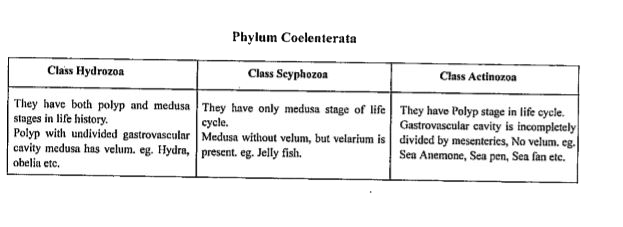Describe important characters of phylum coelenterata and name its classes with examples.
Text Solution
History. Aristotle knew cnidarians due to their stinging nature and called these .Cnide.. Characteristics of Phylum Coelenterata or Cnidaria :
1. Occurrence or Habitat. They are all marine except hydra which is found in fresh water.
2. Polymorphism. Body typically dimporphic (of 2 types)-sessile, cylindrical and hydra-like polyp form and free-swimming, saucer, cup, bell, or umbrella-shaped. Many species include both forms in life cycle. In some, the two basic types are further modified into polymorphic individuals. Anterior end either swollen into a hypostome, bearing terminal mouth, or flattened into an oral disc with central mouth.
3. Appendages. Mouth typically surrounded by highly contractile, thread like sensory tentacles.
4. Symmetry. Basic radial symmetry is diagnostic character.
5. Tissue level of organization. These are next to sponges in advancement of body organization. Physiological division of labour and consequent cell differentiation more eleborate and permanent. Similar cells form permanent epithelial tissues , body organization is of tissue grade..
6. Body cavity. The single body cavity, called coelenteron or astrovascular cavity, is simple or branched, or divided into compartments by longitudinal partitions called mesenteries. It opens out by a single mouth. No anus.
7. Head. Absent.
8. Coelom. Absent.
9. Germinal layers. They are diploblastic ie formed from two embryonic germinal layers ectodrm and endoderm,
10. Bodywall. Both epidermis and gastrodermis are present. Only epidermis, contain certain highly specialized and unique .stinging cells., or .nematoblasts., found nowhere else in the Animal Kingdom. These cells are used for food capture, defence and attachment.
11. Nutrition. Most cnidarians are carnivorous and mainly feed upon small crustaceans of zooplankton. Digestion partly extracellular in gastrovascular cavity and partly intracellular in food vacuoles of some gastrodermal cells.
12. Respiration and excretion. Gaseous exchange and excretion (ammonia) through general body surface.
13. Nervous system. A primitive type of nervous system, without brain, is found in the form of two epidermal nerve nets. Eye-spots (ocelli) and statocysts for equilibrium occur in some.
14. Reproduction. Asexual reproduction by budding or sexual reproduction by fusion of gametes. Life cycle usually exhibits an alternation of generations (metagenesis, which means delay in sexual reproduction) between asexual polypoid (2N) and sexual medusoid phases (2N). A free swimming, ciliated stereogastrula, called planula larva, occurs in the life cycle of most cnidarians. Thus development is indirect.

|
Similar Questions
Knowledge Check
The characteristic larva of phylum coelenterata is
APlanulaBCystecierusCrhabdiformDwriggler
Name three classes of phylum ceolenterata.
View SolutionMention three important characters of the phylum Mollusca.
View SolutionAnimals that belong to phylum Coelenterata.
View SolutionPhylum Cnidaria/Coelenterata
View SolutionGive two important characteristics each of classes of sub-phylum vertebrate. Write one example each class.
View SolutionEnlist six peculiar characters of phylum Mollusca. Name three example.
View SolutionDiscuss the general characters of the phylum Porifera or Coelenterata.
View Solution
